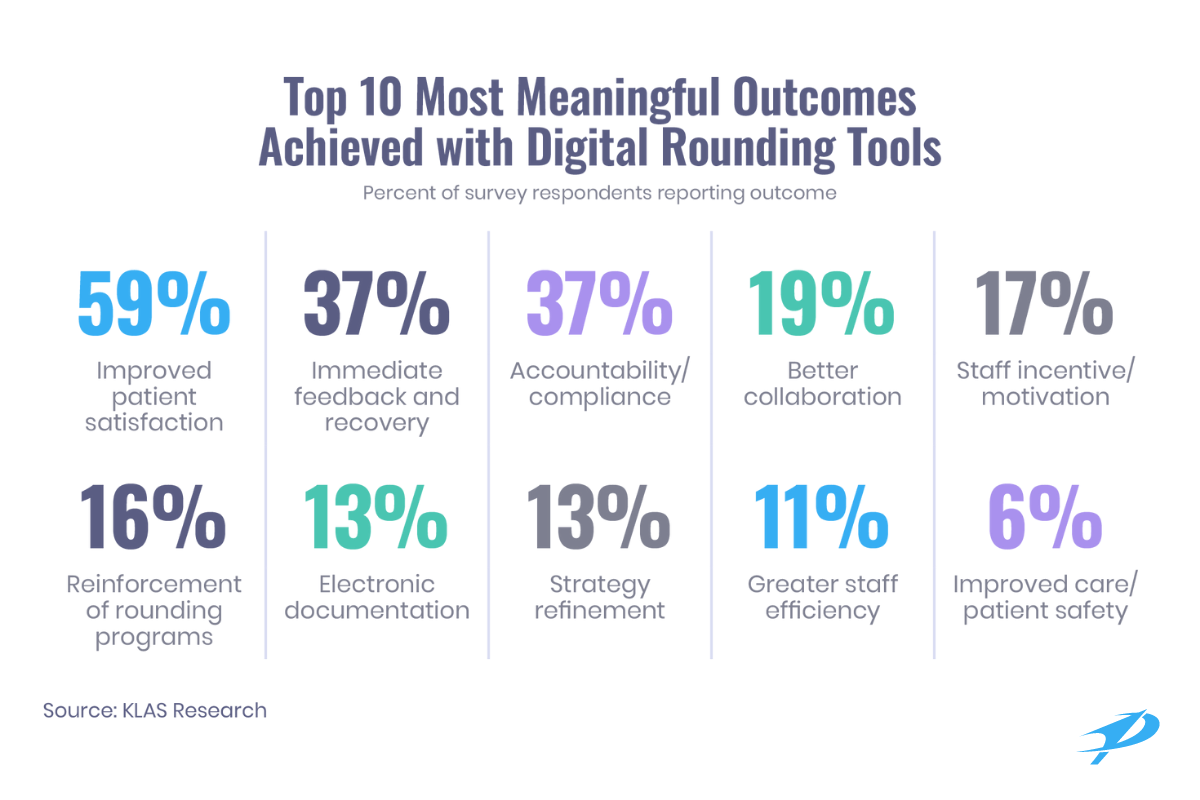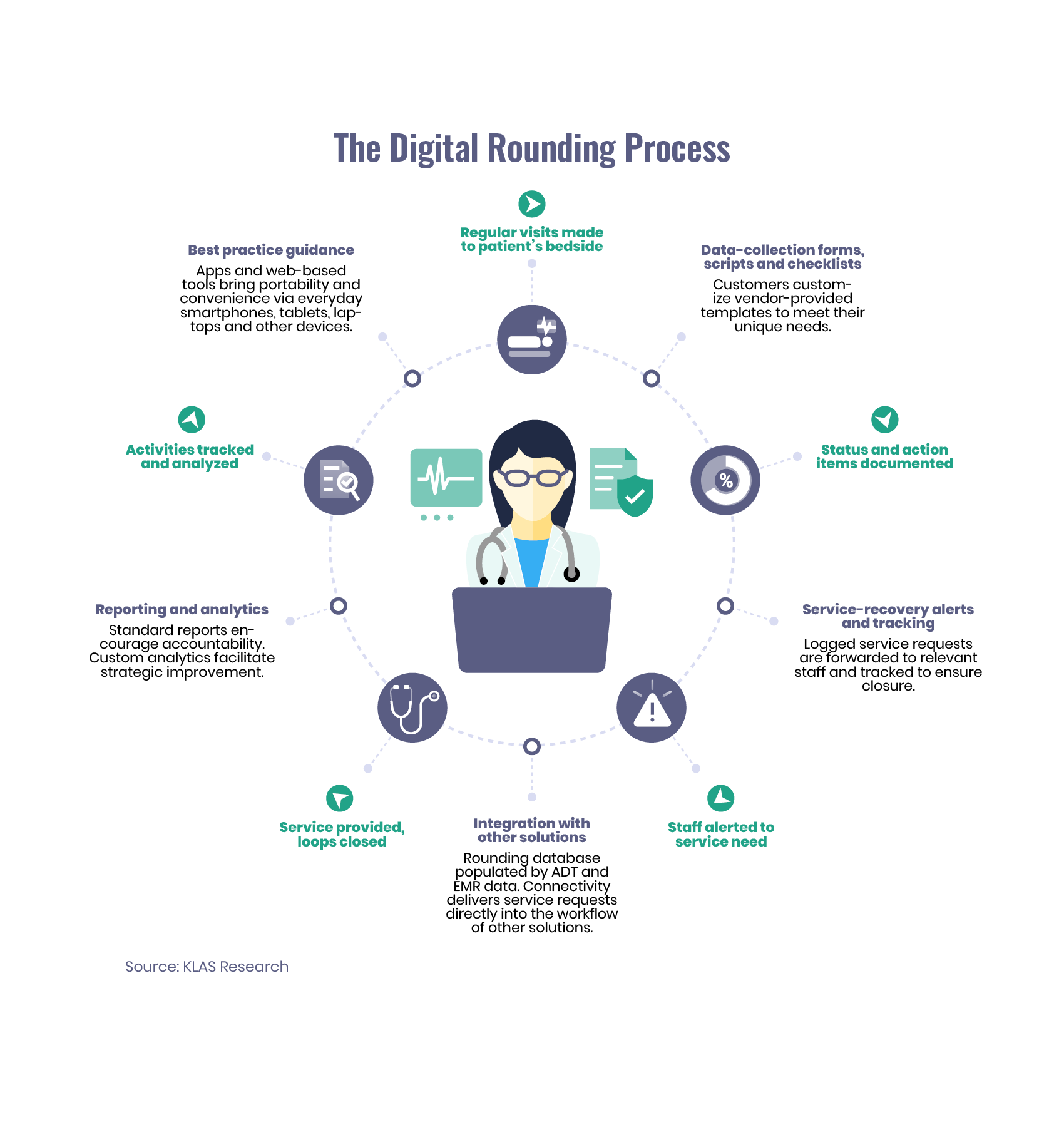5 min read
Rounding Software in Healthcare: An In-Depth Guide
Performance Health Partners
September 11, 2023

Rounding software greatly enhances the efficiency of clinical and non-clinical rounding in healthcare, offering providers streamlined processes tailored to their unique needs. With its focus on promoting coordinated patient care, the software ensures seamless communication and facilitates prompt decision-making. Read on to learn how rounding software can revolutionize your healthcare practices and the key features that make it a game-changer.
Types of Rounding
In healthcare, several types of rounding exist, each tailored to specific purposes and involving a diverse set of healthcare professionals. From bedside check-ins to interdisciplinary consultations, these rounding methods cater to the intricate and varied needs of patient care. Designed meticulously, these rounding types aim to ensure coordinated patient care, foster effective communication, and improve employee and patient safety. A few types of rounding are as follows:
Patient Rounding
Patient rounding is often also referred to as nurse rounding or bedside rounding. It is when nurses regularly visit patients to assess their needs, address concerns, and provide care.
Patient rounding is an essential component of patient centered care and effective communication. During patient rounding, nurses follow a structed process. The frequency of their rounding can vary based on the patients' conditions but typically occur at regular intervals throughout the day.
The goal of patient rounding is to ensure that patients are receiving high quality care and their needs are promptly met. Patient rounding can also help make patients feel educated about their care and engaged in the creation of their treatment plan.
Employee Rounding
Employee rounding is a process in which managers or leaders in an organization regularly engage with their employees to gather feedback, assess their needs, and promote a positive work environment. It is sometimes also called staff rounding or employee engagement rounding. The goal of this rounding is to enhance employee satisfaction and get employees involved in improving organizational performance.
Leadership Rounding
Sometimes also referred to as management rounding or executive rounding, leadership rounding is the practice of organizational leaders regularly engaging with employees, customers, and other stakeholders. They talk to these people to gain feedback and address concerns about the overall state of the organization.
The primary goals of leadership rounding in healthcare are to promote effective communication, identify areas for improvement, and enhance the organization’s performance. This type of rounding also helps to demonstrate the importance of rounding to general staff and provide executive visibility.
Gallup reports that there is a near linear relationship with the more leaders rounded, the greater the engagement of staff and patients. Along with this, their studies show that hospitals with the least engaged nurses pay $1.1 million more annually in malpractice claims than hospitals that have highly engaged nurses.

Optimizing Rounding Processes with Rounding Software
Healthcare rounding software is designed to facilitate and enhance the rounding process. It streamlines communication, documentation, and collaboration among healthcare providers during rounds.
Healthcare organizations typically provide their staff with a patient rounding template to fill out to gather information on each patient. The tools aim to improve patient outcomes, reduce errors, and enhance overall efficiency.
Policies have supported that inpatient settings utilize hourly rounding to help improve visibility of nurses and reduce potential medical errors. Hourly rounding in nurses allows for patients to be regularly seen, but also creates a mass number of paper files in hospitals that do not use digital rounding tools.
Utilizing digital rounding instead of conventional rounding practices is growing in popularity in hospitals across the United States. Switching from pen and paper to electronic forms ensures better tracking and communication of information, providing a more standardized method for data submission and analysis.
In a study performed by KLAS Research, patient rounding technology was found to increase patient satisfaction scores by 59%. Additionally, 37% of the organizations in the study claimed that they benefited from the technology’s immediate feedback and compliance tracking functions.
After looking at a case study from a large medical facility in Virginia, it was found that there was a 78% reduction in fall rate and an 85% reduction in falls that resulted in injury after implementing a digital rounding tool. To assess patient fall risk, this tool enabled nurses to input data based on questions they asked patients during rounds. Depending on the response, the system would automatically trigger a notification, alerting staff that fall mats or fall risk armbands should be implemented.
In 2017, UChicago Medicine implemented digital rounding with a rounds app. After this implementation, the team found that their satisfaction scores rose 30 points. When compared to other facilities contracted with Press Ganey, their scores moved from the 12th percentile to the 67th.
Another successful case is Lenox Hill Hospital in New York that implemented a rounding process using technology. During the Covid-19 pandemic, the team compared the Hospital Consumer Assessment of Healthcare Providers and Systems survey results between patients who experienced digital rounding and those subjected to conventional methods.
Through these surveys, it was found that in almost every domain, there was a 3% to 20% improvement with the group that received digital rounding. Lenox Hill Hospital successfully transitioned its patient rounding sheet to a digital format, enhancing its efficiency and accessibility for staff.

Benefits of Digital Rounding Software
Digital rounding software offers several benefits that contribute to improved patient care. This includes streamlined workflows and enhanced communication among healthcare providers. Below is a list of additional benefits that come from rounding software:
- Efficiency: Digital rounding tools automate various aspects of the rounding process such as patient data retrieval, checklist completion, and documentation. This efficiency saves time for healthcare providers, allowing them to focus more on what matters: patient care.
- Real-Time Access to Patient Information: Healthcare providers can access patient records, test results, and relevant medical information in real time. This immediate access to accurate information supports informed decision-making during rounds.
- Reduced Errors: Rounding software can help reduce errors by providing accurate patient information, helping ensure correct medication administration, and supporting standardized protocols through electronic checklists.
- Standardization: Healthcare organizations can create standardized protocols and checklists. This ensures that critical tasks are consistently performed during rounds, improving patient safety and quality of care.
- Data Analytics: Rounding software is often equipped with data analytics capabilities allowing healthcare organizations to track performance metrics, identify trends, and make data driven improvements.
- Remote Access: Some digital rounding tools offer remote access which enables healthcare providers to conduct rounds and review patient information from anywhere with an internet connection. This is particularly useful for telehealth and remote patient monitoring scenarios.
- Continuity of Care: Digital rounding tools facilitate the transfer of patient information and care plans between shifts and locations, ensuring a smooth transition of care. This reduces the risk of communication gaps between providers.
Features to Look for in Rounding Software
When selecting rounding software, there are several important features to consider. These features contribute to the effectiveness, efficiency, and overall success of the process. Here are some key features to look for:
- User-friendly Interface: The tool should have an intuitive and user-friendly interface that is easy to navigate and use effectively
- Mobile Compatibility: Mobile access is crucial for rounding tools, allowing healthcare providers to access patient information and complete checklists on mobile devices while on-the-go
- Integration with EHR Systems: The tools should seamlessly integrate with the organization’s electronic health record system, allowing for real-time access to patient information.
- Customizable Checklists: The ability to create and customize checklists based on different rounding scenarios and patient conditions ensures that the software aligns with the organization's specific needs
- Secure Messaging: Communication features such as secure messaging or chat allow healthcare providers to communicate and collaborate in real time during rounds
- Data Analytics and Reporting: The rounding software should offer analytics features to track rounding performance, identify trends, and generate reports for quality improvement initiatives
- Security and Compliance: Data security and compliance with healthcare regulations such as HIPAA are essential. Look for tools that prioritize patient data protection and maintain compliance standards.
Ready to learn more?
Healthcare rounding software is essential to a positive patient experience and the success of your organization. Request a free demo with our team to learn more about how Performance Health Partners’ rounding solution is right for your team.



